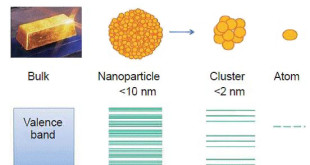Earlier in the year 2018, Hewlett Packard Enterprise (HPE) announced that it had been awarded a large $57m contract from the US Department of Defense (DoD) to provide supercomputers. As supercomputing has become an ever bigger part of the toolset of the department’s scientists and engineers innovating around the most …
Read More »Atomic clusters could lead to new materials from the bottom-up with unique and tailored properties.
Atomic clusters, consisting of a few to a few thousand atoms, have emerged over the past 40 years as the ultimate nanoparticles, whose structure and properties can be controlled one atom at a time. More importantly, the possibility of creating a new class of materials, composed of clusters instead of …
Read More »Next Generation AI and Robots can reproduce and Replicate themselves
Artificial intelligence expert George Zarkadakis believes robots could have sex with each other to evolve and produce superior offspring and this scary new world could be closer than we might imagine. He predicts that humans could even breed with machines to create new hybrid species. Mr Zarkadakis said robots that …
Read More »China develops chip that allows for two-dimensional Quantum walks, have exponential superiority in quantum searching and quantum simulation applications
Quantum walks are the quantum version of classical random walks, which are a mathematical means for describing a natural random walk, e.g., simply wandering around randomly. In a “classical random walk”, you could imagine someone starting at the centre of a city, and making a random decision at each …
Read More »DARPA develops Testbed to test space warfare strategies integrated with air, cyber, land, and maritime domains
As the space domain has become more congested and militarized the potential for intentional and unintentional threats to space system assets has increased. To mitigate these threats, the Department of Defense (DOD) has undertaken a variety of initiatives to enhance its network of sensors and systems to provide space situational awareness …
Read More »DARPA’s APT to transform genetic modified plants into military sensors of chemical, biological, radiological, and electromagnetic signals.
DARPA has launched a new surveillance program which plans to use genetically engineered plant as battlefield surveillance sensors. DARPA’s new Advanced Plant Technologies (APT) program looks to seemingly simple plants as the next generation of intelligence gatherers. Traditional sensors are not always optimal for obtaining timely, accurate information as national security …
Read More »US and China to deploy quantum ghost imaging sensors on battlefield and satellites for stealth plane tracking
China is developing a new type of spy satellite using ghost imaging technology which could spot stealth aircraft and see through smokescreens and camouflage. Ron Meyers, quantum physicist at the Army Research Laboratory. Meyers explained ghost imaging, a technique that allows a high resolution camera to produce an image …
Read More »DARPA exploring the convergence of biology and electromagnetics for military communications and sensing
Radio frequency waves (RF) are electromagnetic waves between the frequencies of 3 kilohertz to 300 gigahertz, used in radio, cellphones, wi-fi, radar, GPS, and many other systems. While humans have used RF technology to communicate for over 100 years, no living organism has ever been observed using RF to communicate …
Read More »Datacenter-on-chip technology that compacts a huge data center on single chip will play big role in Big Data analytics for US Army
The technology industry is entering a new era of computing that requires IT systems and cloud computing services to process and analyze huge volumes of Big Data in real time. Current Data centers (DC) and high performance computing clusters are dominated by power, thermal, and area constraints. Data centers …
Read More »Russian Physicists’ Research Might Lead to a New Generation of Microprocessors, microminiature nanolaser, and long-range space communication systems
REEs are a series of chemical elements found in the Earth’s crust that are essential components of many technologies, including electronics, computer and communication systems, transportation, health care, and national defense. Rare Earths Elements (REE) are incorporated into many sophisticated technologies with both commercial and defense applications including smartphones and …
Read More » International Defense Security & Technology Your trusted Source for News, Research and Analysis
International Defense Security & Technology Your trusted Source for News, Research and Analysis










